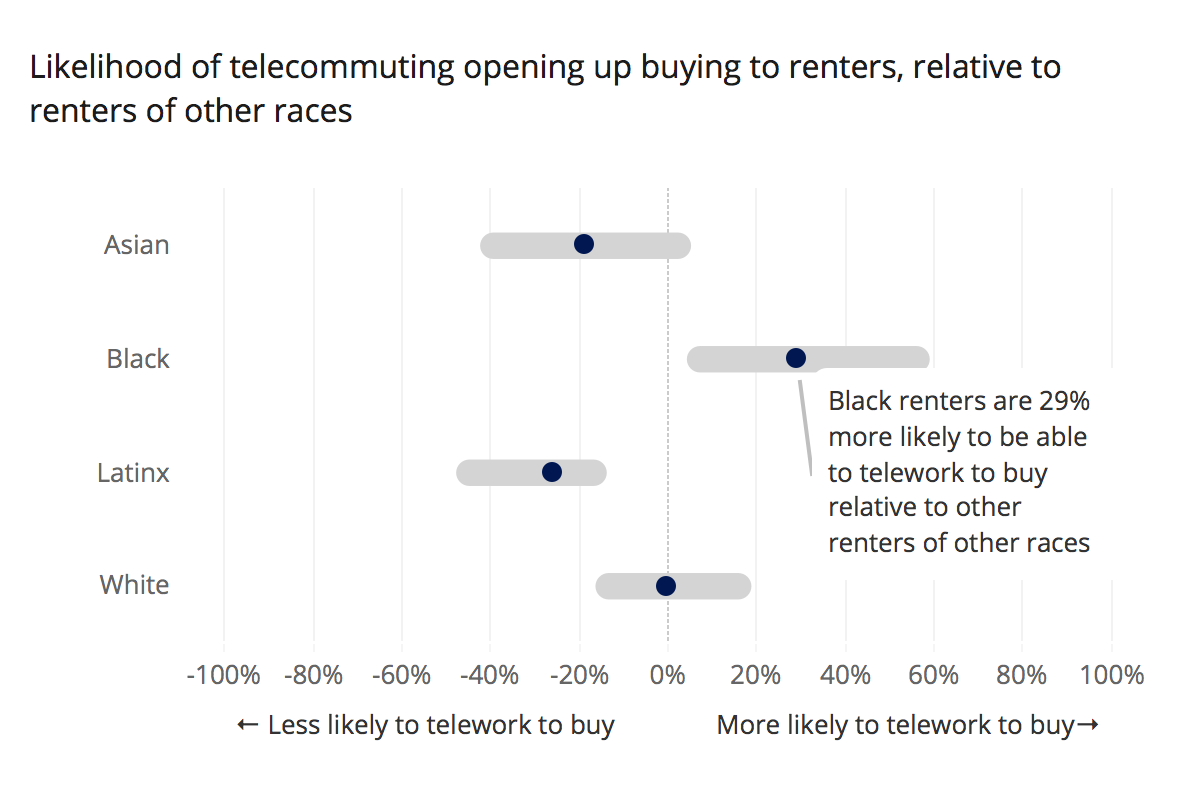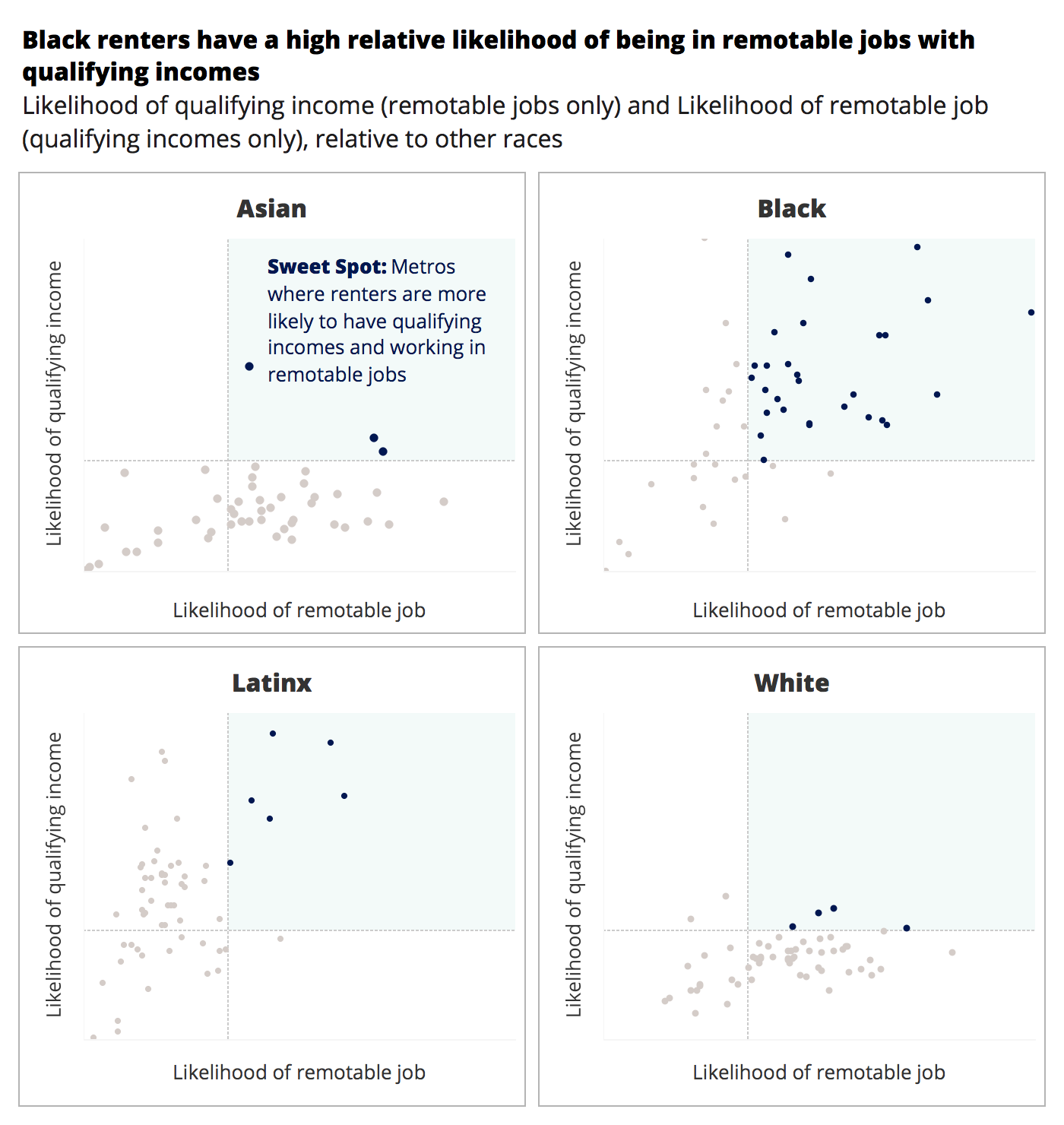Working From Home Could More Widely Benefit Black Renters Seeking Homeownership
Black renters are 29% more likely than other renters to potentially be able to move and buy a first home because of the rise in telework.

Black renters are 29% more likely than other renters to potentially be able to move and buy a first home because of the rise in telework.

Black renters are far more likely than renters of other races to be able to make the jump into homeownership by taking advantage of enhanced telework options in most of the country, boosted in large part by where they live, how much they generally earn and the jobs they tend to hold.
Prior Zillow research found that telework could open up homeownership for almost 2 million U.S. renters that can’t afford to buy a home where they currently live but could on paper afford a home in a less-expensive locale, about 4.5% of U.S. renter households. But these opportunities are not available equally, and a shift to more telework will have different effects on homeownership across races — and, on its own, will do little to close the yawning homeownership gap between white households and households of color.
And while some households may choose to move to achieve homeownership and the benefits it brings, it’s unrealistic to expect any mass movement away from communities people love and have ties to in favor of moving somewhere they can better afford. The larger-scale solution to closing the homeownership gap must be to create more options for affordable homeownership in more areas of the country.
Experts routinely advise households not to spend more than 30% of their income on housing, in order to leave room in their budgets to adequately afford other expenses. The typical U.S. starter home is valued at about $132,000, and would cost about $725 per month assuming current low interest rates and a 20% down payment, or almost exactly 30% of income for a household earning $29,500 per year. Starter homes typically cost less than $132,000 in about half the country, even many large metropolitan areas, including Oklahoma City, Cincinnati, Pittsburgh and Detroit.
But in 37 of the nation’s 50 largest metro areas — home to the bulk of the nation’s jobs — a local starter home is more expensive than the typical starter home nationwide. And in three-quarters (28) of those markets, Black renters are more likely than most to be in a position where telecommuting makes buying more accessible. At the median, Black renters are 29% more likely than other renters to be able to buy their first home in a less-expensive area from which they could potentially telecommute to their current job. Asian, Latinx and White renters are 19%, 26.2% and 0.6% less likely than other renters, respectively, to be able to telecommute and buy.
The differences come down to a series of factors including local housing costs, how much renter households earn and how “remotable” — the ability to do the work without necessarily going to an office or worksite — a given job is.


Higher-paying jobs are generally more “remotable,” but the potential boost to homeownership from enhanced telework is larger for those generally earning low-middle incomes in industries that allow them to work remotely. In Baltimore, for example, a household earning $30,000-$40,000 per year is more likely to have a primary breadwinner that works in health care administration or other office work, which is highly remotable. But in Phoenix, it is more common for someone earning that rough salary to work in accommodation or food service, which is not remotable work.
These geographic and industry factors, rather than income levels, are the largest differentiators between Black and Latinx renters in particular regarding their potential ability to relocate to buy a home while staying in the same job. Because of their general concentration as workers in industries that don’t lend themselves to easy remote work, Latinx renters are far less likely to be able to telework to buy, despite having broadly similar income levels as Black renters. When controlling for their being in the right income range, Latinx renters are 43% less likely than non-Latinx renters to be able to telework and buy — their incomes put them in range, but their jobs generally do not.
In most metros, renters either earn a low-middle income that might prompt a move, but work in less-remotable occupations; or they earn much higher incomes and work in more-remotable jobs — and so may not need to take advantage of telework in order to buy a home. Relatively few renters occupy the sweet spot where both qualifying income and telework flexibility are both likely.
But controlling for both income and occupation and only looking at incomes for those who could telework and only looking at telework for those with the right income, the racial dividing lines are clear. Latinx renters with qualifying incomes are generally much less likely to be able to telework. White renters are more likely to be able to telework but their incomes fall into the relevant range at a much lower rate. Asian renters follow a similar pattern to whites but even moreso. Only Black renters have both a high relative likelihood to be in remotable jobs and at broadly qualifying incomes.

While 4.5% of all U.S. renter households could theoretically telework and move to buy a home, the national figures vary considerably by race: 9% of Asian renters, 5% of Latinx renters, 4.1% of white renters and just 3.7% of Black renters would be in a position to telework to buy. But all real estate is local, and the national numbers are not very good at telling the local story — they offer some perspective on how much national homeownership rates by race may change, but don’t quantify the actual local opportunities people have where they live. The national figures overstate the share of households with remotable work for Asian renters, and understate it for Black renters.
The Black homeownership rate has improved in recent years, but remains upsettingly low, especially relative to the white homeownership rate, and is both a symptom and a cause of lower economic opportunity for the nation’s Black communities. It will take years of concerted effort to meaningfully close the gap, and the data make it clear that any positive changes resulting from an increased ability to telework will not, on their own, be a major factor in closing it. But locally, market-by-market, it will tend to be beneficial to more Black renters trying to make the transition to homeownership.